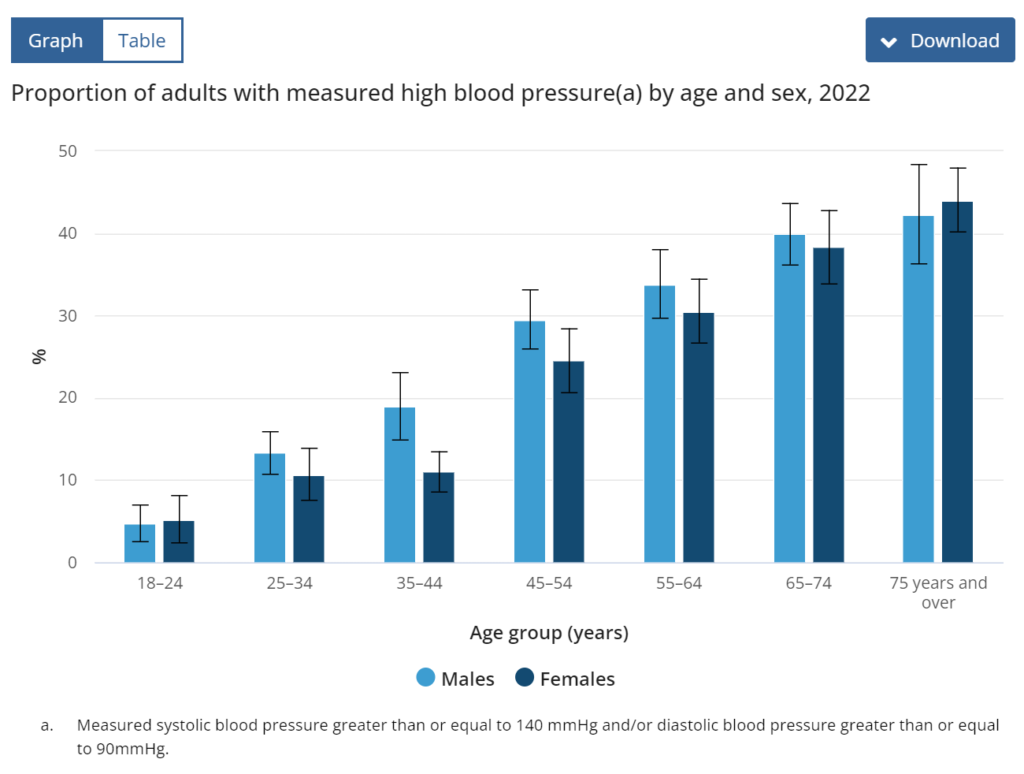Big muscles and lifting heavy weights may be attractive benefits of regular physical activity, but our health goes beyond appearances. At Hobart Strength Training, our aim is to make you Stronger for Life, not just in the gym but also against major health threats like hypertension. Hypertension, or high blood pressure, is a leading cause of premature death worldwide, claiming over 10 million lives annually (1). Known as the “silent killer” due to its often-symptomless nature, it’s crucial to manage. While these tips are not medical advice, they will set you on the right path to managing blood pressure levels. Of course, if you do have any concerns, please speak to your primary care physician.
Routine Checks and Hypertension
To begin, blood pressure measures the force of blood against artery walls. When the heart contracts, pressure rises (systolic), and when it relaxes, pressure falls (diastolic). A healthy reading is typically around 120/80 mmHg. Hypertension, or high blood pressure, is defined as 140/90 mmHg or higher. Being on medication for hypertension may also define a person as having the condition. High blood pressure increases the risk of heart attack and stroke. In Australia, around one in five adults had high blood pressure in 2022, with rates rising with age (3, 4). Adults over 18 should get checked at least once every two years, but more frequent checks are possible. You can even monitor your blood pressure at home. Ensure you choose a validated monitor – we have a link to a fantastic resource you can check out here. Additionally, the Heart Foundation offers a guide for tracking your blood pressure at home.
Participate in Regular Physical Activity
Physical activity offers numerous health benefits, including helping prevent and manage hypertension. Physical activity includes both cardiovascular and resistance training. Guidelines recommend 150-300 minutes of moderate-intensity or 75-150 minutes of vigorous-intensity cardiovascular activity per week (1, 5). When broken down, this could be a brisk walk for 22 minutes daily. What’s brisk? Fast enough that you can’t sing without taking a breath. Wearable fitness trackers, like an Apple Watch, can help track your pace too. Resistance training is also beneficial, with at least 2 full-body sessions per week recommended. At Hobart Strength Training, we specialize in helping adults of all abilities improve their health through strength training. If you’re interested in learning more about progressive resistance training, you can find more information here.
Manage other Lifestyle Factors such as Diet and Stress
Understanding the importance of routine checks and prioritizing physical activity, what other factors are relevant for managing hypertension? We suggest two more: dietary modification and stress management. A diet rich in whole grains, fruits, vegetables, and polyunsaturated fats, while reducing added sugars, saturated fats, and trans fats, is effective. The DASH diet is a great example (2, 5). Foods high in nitrates, like leafy vegetables and beetroot, also seem protective. Minimizing processed and high-salt foods can reduce blood pressure. Lastly, strategies like meditation, mindfulness, and better sleep quality can reduce chronic stress. This reduction in chronic stress may positively impact blood pressure. We believe in simple, accessible strategies, so dietary and stress management are important levers to pull.
Stay on top of Hypertension
Managing blood pressure early is crucial because high blood pressure’s effects accumulate over time. This phenomenon is known as cumulative exposure risk. Simply put, it’s important to get onto of blood pressure, early. Simply steps like regular check-ups, increased physical activity, and managing diet and stress are recommended strategies for everyone. Lifestyle changes are important, but medication can be a valuable tool. If you’re seeking evidence-based practitioners who prioritize holistic health, Hobart Strength Training is the place for you. Get in touch with us today.
References:
- Hypertension (who.int)
- 2020 International Society of Hypertension Global Hypertension Practice Guidelines | Hypertension (ahajournals.org)
- Heart, stroke and vascular disease: Australian facts, High blood pressure – Australian Institute of Health and Welfare (aihw.gov.au)
- Hypertension and high measured blood pressure, 2022 | Australian Bureau of Statistics (abs.gov.au)
- High blood pressure (hypertension) | healthdirect

